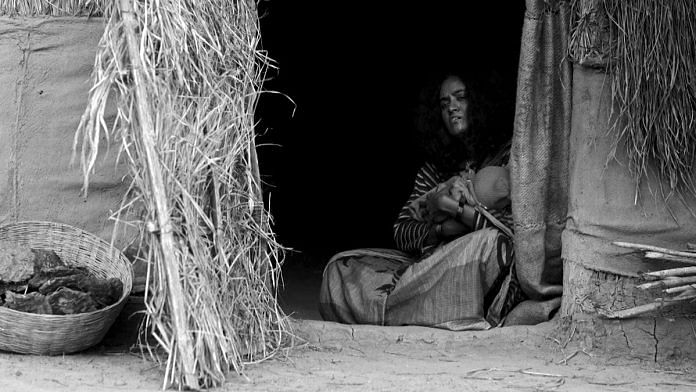New Delhi: Filmmaker Abhilash Sharma had to combat his childhood fears and ignorance to make the Magahi-language movie Swaha. Through the story of a couple from Bihar’s marginalised Musahar community of rat eaters, he tackles discrimination, desperation and exploitation.
As a child, Sharma would stay with his grandmother in Painal village during the school holidays. On one of his visits, he saw a woman eating rats. His fear and disgust were bolstered by villagers telling him that the Musahars were evil.
“And I believed it. It was only later that I realised that for them, it was simply a matter of surviving,” he said.
Swaha is an attempt to address this ignorance, and he deliberately chose to make it in Magahi.
“The rat eater community live in Gaya and the Magahi language is spoken there. But it is also my mother tongue, so I wanted to use it,” said Sharma.
The result is a stark and hard-hitting commentary on power and subservience. Shot in black and white, the movie shows that violence is systemic—rooted in both class and caste. Humanity is sacrificed at the altar of land, money and power.
“The film looks at how intersections of religion and caste lead to economic disparities that foster division and animosity,” said Sharma.
Also read: ‘In Retreat’ film shows a different side of Ladakh. It’s not like Aamir Khan’s 3 Idiots
A cycle of violence
Set on the outskirts of Manowara village, the movie turns its gaze on a couple from the Musahar community, Rukhiya (Sonalli Sharmisstha) and Phekan (Satya Ranjan), and their infant son. They survive on scraps of food that Phekan gets from working as a labourer.
But he dreams of a better life. Phekan travels to the big city, Gaya, and starts working at a brick kiln. He even puts up posters for a political leader’s election campaign, for money.
Everyone tries to take advantage of everyone. As Phekan is trying to find the next gig, he witnesses an official try to assault a woman employee.
Despite his circumstances, he never gives up hope. He even helps a stranded cart owner who is stuck on the train tracks. But no one returns the favour when rumours spread that he is a child trafficker. He is beaten up and left to die outside the railway station.
Back in Manowara village, Rukhiya is being targeted as a witch. It takes a toll on her mental health. She is haunted by voices and in an act of desperation, sets her home on fire. She ends her life in the hope that her child will no longer be associated with them and their community.
“The title Swaha is rooted in a Hindu ritual signifying an offering to the fire god, symbolising the fulfilment of desires and wishes. In our film, the protagonist’s journey reflects this concept,” said Sharma.
Also read: ‘Jal Tu Jalaal Tu’ not an aspirational film about workers—it celebrates their laughter, humanity
Shooting in black and white
Sharma was inspired to make Swaha after watching Alan Becker’s 2006 animated web series, Animator vs. Animation.
“The exploration of the dynamic between creator and creation fascinated me, and my film’s plot evolved into a narrative focusing on a struggling mother and her child,” said Sharma.
Buddhism has also influenced the narrative, not just because of the location, but Sharma’s own connection to its ideals—compassion, the path to enlightenment, and how suffering plays out in the world.
The film premiered in June at the 2024 Shanghai International Film Festival, China in the Asian New Talent Competition Section where it won two Golden Goblet Awards for Best Director and Best Actor (Satya Ranjan).
It will be screened in the ‘Indian Cinema Now’ section of the International Film Festival of Kerala, which began on 13 December.
“Before I started making the film, and while researching we looked at a few photos, and my cinematographer decided to make it black and white. We shot in colour, but in post-production, we realised the black and white looked better,” said Sharma.
For Sharma, making this film has been an exercise in learning, he’s been voraciously consuming content to make his craft better.
“After shooting my movie, I saw Gautam Ghose’s Paar (1984), I felt like I could have done my film even better,” said Sharma.
In the final moments, the black and white gives way to colour. It’s a sign of hope.
This article is part of ThePrint’s monthly series on independent films. Views are personal.
(Edited by Theres Sudeep)






